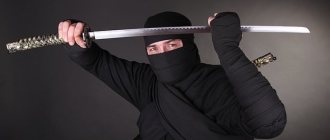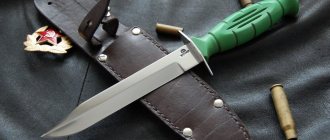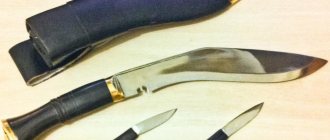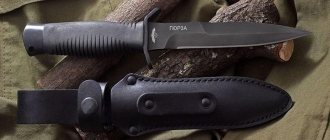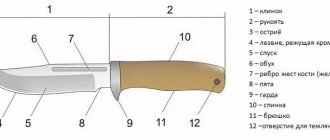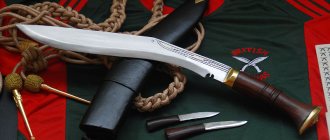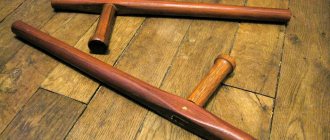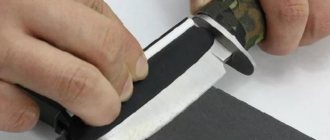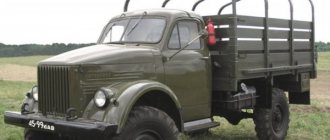Probably every nation has its own national blade, the historical roots of which are quite deep and varied. Such knives can be easily compared with absolutely any objects from many years ago, and which can be considered part of the national heritage and everyday life. The Finnish people have such a rather curious object - this is the Puukko knife.
Diamond-shaped Puukko knife.
Story
The time when Finnish Puukko knives appeared is not known for certain. But during archaeological excavations, bone blades of a similar shape were found. And more civilized specimens date back to the Bronze Age, and they are practically indistinguishable from modern species.
Small size, specific shape and wooden handle are the distinctive features of this historical blade; it cannot be confused with anything. The word “Puukko” translated means a knife with a wooden handle. And its spelling in Finnish looks like this – puukko.
According to many historical sources, any other explanation of the origin of this word is incorrect. But as you know, all Finnish knives began to be called the Puukko knife only in the 18th century. In itself, it is as simple as possible and does not have any sophisticated forms. This form and simplicity appealed to the whole of Northern Europe and a large part of Russia. In addition, it became the prototype for the HP-40 scout knife.
The blade at one time spread quite widely throughout the territory of the former Soviet Union and bore a simple and short name - finka. And he was quite popular among the criminal element. It’s difficult to say what the Finns think about this, but at least it’s unpleasant to know that your national treasure is being manipulated by bandits. And in fact, few people know that the history of this blade began back in the Bronze Age. And it continues to this day. The Finnish hunting Puukko also has a kind of brother - Leuku.
If you dig a little deeper, you can see its many varieties, the common features are preserved, but some specimens have slight differences.
It depended on the place of manufacture and the future purpose of the blade. Its distribution has reached such proportions that wearing it in the city has been prohibited since 1977, but in the forest you can do whatever you want with it.
Features of the national knife Puukko
The design of the Finnish Puukko knife itself, as already mentioned, is quite simple. A straight and short blade with a fairly thick spine of 5 mm. The handle is uniform and does not have any anatomical grooves or cutouts. And it is larger in size than the blade itself. Briefly it can be characterized by the following features:
- the blade had a length of 10-15 cm, but usually something in between 12-13 cm;
- the wood from which the handle was made was impregnated with oil or paraffin; the material was usually Karelian birch;
- there was a fitting at the entrance of the blade into the handle;
- the blade had a Scandinavian bevel with a straight spine without fullers;
- The handle is barrel-shaped, with a slight bend at the end.
Finnish national knife Puukko.
There are even drawings of the Finnish Puukko knife. You need to hold it in a special way. The handle must be rested in the palm of your hand and held with three fingers; the other part is held with the remaining two fingers. This holding method is called the Finnish grip. The method takes time to learn. But having learned to hold it correctly, it becomes a formidable weapon, self-defense or attack.
Finnish knife blades
The length of the blade, as already mentioned, is quite small, only 10 cm. Sometimes they were found with fullers on the blade. The dol must be forged, and not just cut out with a grinder. Otherwise it loses all meaning and weakens the blade itself. But this is rather a trend of modern, more fashionable options. Making a fuller on a blade 10-12 cm long is absolute stupidity. Some fans call it “bloodstock”, but this is incorrect.
The descent on the blade began approximately from the middle, thanks to which it had an excellent cut. Sharpening such a blade was not difficult. The decorations on it have never been done before. Again, in more modern replicas, you can see a decorated hilt or the blade itself. According to some reports, jewelry began to appear in 1880, but was quite rare.
Handle and sheath of Finnish knives
The handle is usually made of wood. For reliability, use the root part of the tree. In modern replicas you can also find plastic, but to be honest, in this design, this is far from a Finnish Puukko knife. Most often, swamp birch was used to make the handle; in our country it is known as Karelian. Again in a modern design, exotic trees and inserts made of copper, bone or horn are often used.
Finnish Puukko knife and case for it.
Separately, I would like to talk about the sheath of the Puukko knife. In the 19th century, craftsmen began to paint them in different colors. Until then, the sheath was woven from birch bark or simply made of wood. But today they have truly become a work of art. Many craftsmen try to approach this matter quite creatively. It also happens that a simple, inconspicuous-looking blade has a beautiful sheath.
Price of Finnish Puukko knives
The cost of products depends on: the grade of steel used in manufacturing, the total size of the product and the company that produces the cutter. The leather sheath adds considerable cost. Some of the most expensive knives are made of Carbon steel; the handle is traditionally made of Karelian birch. Prices for decent Puukko products range from 5-9 thousand rubles. Collectible models will cost more from 15 to 60 thousand.
Manufacturing materials
For the manufacture of serial budget knives, steel with a relatively low percentage of carbon content (0.6–0.8%) is used. More expensive models are made from a high-carbon variety (1.2%) with alloying additives. Nickel provides protection against rust, chrome provides better wear resistance. The hardness of the material is 58–62 units on the Rockwell scale. Damascus steel is used on collectible models.
When the hardness of steel is less than 55 units, a product made from it is no longer a knife that can be used for its intended purpose, but just a souvenir, and of rather low quality.
The handle is most often made from hardwood. In addition to the Karelian birch, its burl is, for example, the root burl of willow, rowan, alder, walnut, boxwood. Another popular option is deer or elk antlers. Budget models may have a plastic handle, while expensive ones may have exotic wood (ebony, rosewood).
Types of Finnish hunting knife Puukko
The variety of cutters is amazing. They are divided by purpose, regions of the country and in accordance with historical events. Quite a complex classification structure. The process of making a cutter is inherent in every Finnish family. It seems that even a child can make a Finnish hunting knife. It is rare to find peoples capable of preserving centuries-old traditions.
Products with interesting names
The names of these knives carry a piece of historical event. Or the blade was dedicated to a famous person. They have external distinctive features, but belong to Puukko knives:
- A product that does not have the official status of weapons of the Finnish army. Manufactured during the Soviet-Finnish and World War II, it has the name - Sotapuukko. It is slightly larger in size than a typical Finnish hunting knife. Some blades bear the names of the owner's units. The scabbard was made from the aluminum skin of enemy aircraft.
Note the scabbard from the enemy fuselage. - An interesting specimen related to collectible models is Olympia . They were produced for the failed 1940 Olympics. Similar products were produced in 1952, again in honor of the Olympic Games.
- Today's attribute of the Finnish national army is Svinhufvudin . Acquired a name in honor of one of the country's presidents. He always carried a similar cutter with him.
- A popular product among American soldiers during the war in Vietnam - Vietnamin puukko. It looks like a survival knife with a saw on the butt and a spear-shaped blade. A pronounced guard and a hollow handle are evident. Its dimensions are large for a Puukko knife, but it is one.
- A well-known model is Wirkkala puukko . The cutter is named after its designer. The knife has been produced by several companies since the 60s of the last century to this day.
- A peculiar guard of Finnish hunting knives - Lynx. It has a traditional shape; translated it means lynx. It has been produced for quite a long time and continues to this day.
Gift version of the Lynx knife. - A popular bayonet model is Sissipuukko . The creator of the product is Finnish officer Peltonnen. Gained popularity among fans of military weapons.
There are many more models in reality. And this pleases buyers and collectors. But it is unlikely that it will be possible to completely collect all varieties.
Varieties according to regional characteristics
A similar division is present in the regional production of knives. This is due to the customs of local residents, who have been passing on the skill of making cutters for centuries. Let's look at some of them:
- visually attractive blade - Vöyri puukko has a brass bolster and pommel of the handle. On some specimens the handle is made entirely of metal. The brass-finished steel sheath and the product itself look quite attractive. A Puukko knife of this model is often used as ceremonial uniform;
- The Finnish municipality of Kauhava produces knives - Kauhava puukko . But there are a lot of manufacturing companies there. It is easy to find cutters with the same name, but they will look different;
- a simple working cutter - Jalasjärvi puukko , there are no frills in the form of brass decorations. Its special feature is its unusual sheath. They bend at the very tip;
- but the product - Kalajokilaakso puukko , on the contrary, has a chic decoration of the hilt and sheath. Such specimens are classified as collectible and gift models.
A collectible item from Finnish craftsmen.
Each cutter is unique in its own way. The products are really beautiful and, in addition, functional. But some of them will feel awkward picking or whittling a log, and you shouldn’t even think about the loafing - your heart won’t be able to stand it, for fear of spoiling such beauty.
Division by purpose of instruments
For every cutter, its practical application is important. In everyday life, hunting or fishing, Puukko knives perform well. But for each manipulation there is its own product model. Consider the table below:
| Knife name | Purpose |
| Metsästyspuukko | Universal knife for hunting |
| Vaarinpuukko | Small hunting knife |
| Eräpuukko | Large hunting cutter |
| Yleispuukko | Carpentry work |
| Vuolupuukko | Wood carving |
| Avauspuukko | Small game dressing |
| Nylkypuukko | Skinning tool |
| Partiopuukko | Tool for beginners |
| Fileerauspuukko | Sirloin cuts |
| Pikkunikkarinpuukko | Children's version of the knife |
Eräpuukko.
Avauspuukko.
Nylkypuukko.
Pikkunikkarinpuukko.
Vaarinpuukko.
Vuolupuukko.
Yes, Finns are taught to use a cutter from childhood. This is normal for them. In the country of the Soviets, every street boy had a small pocket in his pocket, but times and customs change, and cutters were replaced by telephones.
How the utility knife Puukko became a bladed weapon of Finnish warriors
During the pre-revolutionary Russian Empire, it was common to have a knife with you, especially among peasants. After all, a working person in those days simply could not do without such an accessory. It was later that they began to be prohibited from being worn freely.
But the most interesting thing is that during the Soviet-Finnish War, the soldiers of the Red Army were faced with battle tactics that were unusual for them. In Finland at that time, every man knew how to handle a Puukko knife from childhood. And the tactics were quite simple and effective.
The Finns raided Russian troops at night, in the dark and silently, skillfully wielding a small blade, they cut out soldiers and took away ammunition and food. Or they dressed in white coats, hid in the snow along the road, and, having waited for the enemy, attacked him with firearms. And the wounded soldiers were finished off with the same small and rather deadly blade. At that very time, rumors began to circulate about the Finns' deadly weapons.
The most interesting thing is that the Red Army at that time did not have any bladed weapons. But seeing how professionally the enemy wielded a blade, the Red Army soldiers began to arm themselves with captured knives.
Origin and traditions of knife fighting in Finland
Finn with a knife
You can learn about the era of knife fights, which is also called “the time of bad people” or “the era of knife fighters,” from the book “The World History of Knife Fighting” by V. D. Cherevichnik. It lasted in Finland for almost a hundred years (XVIII-XIX), and the population of the region of Pohjanmaa or Southern Ostrobothnia showed itself especially clearly in it.
The population of this area has always been quite warlike. The Finns went on predatory campaigns against the Karelians; they, in turn, did not lag behind and returned the favor to their neighbors. And since the twelfth century, this area was part of the Swedish kingdom, which allowed Swedish traditions to penetrate the life of the Finns. Including the tradition of knife fights, which was so widespread in Scandinavia that in 1860 a monument to knife fighters was erected in Stockholm, which depicts a traditional Swedish knife duel.
The features of these duels were described in 1835 by the French traveler Jean-Jacques Ampere in his work “Essays on the North.” According to him, the Swedes and Norwegians, on the one hand, were extremely hot-tempered, especially under the influence of alcohol, and on the other, quite cold-blooded, which resulted in such a tradition: during any quarrel, the fighters would forcefully stick their knives into a wooden table or wall. The depth to which opponents would stick their blades into the opponent’s body depended on the depth of the knife inserted.
To limit this depth, the blade was wrapped in fabric or leather strips, the opponents were tied with belts, and they briskly began to chop each other with knives. According to the author, such a fight rarely went without injury or death to opponents, and Scandinavian women always carried fabric with them to bandage their husbands and lovers.
The second type of duel required that the opponents hold each other tightly by their left fists, and with their right hand with a knife they try to rip out the opponent’s guts.
The Swedish government brutally uprooted all these good traditions with the help of exile to hard labor, but this did not prevent the Finns from adopting knife habits through fights in port cities.
Use of traditional Puukko in the Red Army
The trophies produced positive results; ski squads and scouts began to arm themselves with them. Several months of combat made it clear that edged weapons were simply necessary for the soldiers of the Red Army. But you had to be able to handle a real Puukko, as mentioned above, for this you had to use a special Finnish knife grip. And there were problems with this. The Russians did not know how to hold it correctly and often injured themselves. And the command decided to develop its own version of the Finnish knife.
One of the varieties of Pukko knife.
Changes in design over time
Russian manufacturers of edged weapons can no longer imagine a model range of knives without the classic Finnish knife. The market is oversaturated with replicas of the legendary Finnish woman.
Constructive evolution allows us to classify an object as a hunting knife or an irreplaceable household item (for example, a tourist knife).
Thus, modifications of the Finnish weapon do not belong to the types of edged weapons and it is possible to purchase the necessary copy, both with and without permission from the Ministry of Internal Affairs. For your information, the model is “Finka-2”, which refers to tourist equipment. Although the knife completely imitates the original, one might say classic, image.
The material for making the handle is varied. The most commonly used raw materials are: plastic, leather, birch bark and wood (sometimes valuable species: Karelian birch and walnut). To freely purchase a replica of a Finnish knife, the thickness of the blade was reduced to 2.4 mm.
Another model is “Finka-3” with a blade thickness of 4 mm, which corresponds to the size of the original. However, the absence of a stop (guard) allows the knife to avoid being classified as a bladed weapon.
Interesting fact! The prototype of "Finky-3" was used by agents of the Soviet secret services, since its dimensions were suitable for invisible wear.
In foreign countries, Finnish knives from Russian manufacturers are sometimes found. So, for example, in Germany, where the legislation on the acquisition of weapons is quite liberal, the Russian one offers to purchase an actual replica of the Vachin Finka “Finka NKVD”. The approximate cost of a copy varies from €140 to €155.
How Puukko's knife turned into a gangster Finn
After the end of the war, previously developed knives for combat were adopted by the NKVD. The Finnish Puukko knife now has a guard, albeit a small one, and a longer blade. Such weapons were much easier to control. But even before the beginning of the 20th century, the criminal world was already making full use of this small and powerful blade for its own evil purposes.
And when the modified Finnish blade appeared, it gradually went to the masses; unfortunately, the purpose of its use was negative. In the world of thieves and bandits, this bladed weapon was given a simple name - finka. But at that time, the resemblance to a real Finnish blade had practically disappeared. The Criminal Code provided penalties for carrying and selling such items.
There were craftsmen who made such blades; stacked plexiglass handles spoke volumes to those in the know. They were glorified in thieves' folklore and the owners of such bladed weapons were respected in certain circles. To be honest, any knife gradually began to be called a Finnish knife. And the resemblance to a real Puukko knife has completely disappeared.
Why is it considered a combat knife?
Only at the beginning of the twentieth century did Finnish knives begin to appear in Russia. Criminal elements were among the first to appreciate the new type. The small size made it possible to discreetly hide the blade behind a waist belt, in the sleeve and boot top. Every criminal considered it obligatory to purchase a Finnish car.
Later, the population of the country appreciated the advantage of the new knife over others and it was renamed the Finn. Having adopted the basic manufacturing technique and improved it, Russian gunsmiths quickly launched production of the product. Externally, the knife already looked a little different. In Russian version:
- there is a groove on the blades;
- a guard appeared - the division of the blade and handle.
In 1935, the Finnish knife became a prohibited weapon on the territory of the USSR. But the Criminal Code, by banning the finca (until 1996), only increased its value. Anyone who dared to wear a finca among criminals became an authority. In the Soviet-Finnish conflict of 1939, small squads of Finnish skiers armed with puukkos caused great damage to the Soviet military by alternating ambushes with raids on patrols at night.
But in addition to using the blade as a weapon, the blade performed many other military tasks necessary for a soldier:
- equipment for combat locations;
- production of snowshoes and stretchers;
- ammunition repair;
- cooking and preparing a place to spend the night.
The Finnish soldiers' knife was practical. It was taken out silently and was convenient in hand-to-hand combat. The razor-sharp blade cut bread perfectly and removed Soviet army sentries.
The Red Army had to accept the evidence of the successful use of the Finnish gun. And exactly one year later, the “scout” knife was approved for use in our Army. The principle of hand-to-hand combat with and against a knife was developed.
The Finnish blade remains popular in both countries today. A variety of its modifications are offered on the market. Numerous mentions of this type of knife in twentieth-century fiction gave it a reputation as a dangerous weapon for decades.
Russian Finnish woman and her features
When the conversation starts about the Russian Finnish knife, you need to understand that we are talking more about the HP-40 scout knife. And it was already quite noticeably different from the real Finnish Puukko knife from Finland. They began to use this modification in the 40s. The differences can be briefly described as follows:
- obvious guard on the blade, S-shaped;
- the bevel on the blade has moved closer to the end;
- the knife itself has increased in size;
- the handle acquired anatomical characteristics.
Replica of the Russian Finnish Red Army.
But during the Great Patriotic War, the soldiers of the Finnish army must be given credit for their ability to work more efficiently with their knives. And they armed themselves only with their national Puukko; they did not need any other modifications.
Recommendations
The price of replica NKVD knives on the modern market ranges from 150-200 dollars (9-12 thousand rubles). The final cost is affected by age, equipment and material of manufacture. Early copies are valued higher, as they are considered to closely imitate the original finca. Initially, the blade in question belonged purely to specialized military weapons. Now such products are usually positioned as collectible or souvenir exhibits. It is recommended to purchase the original in the presence of an experienced antiquarian. It will help not only determine the authenticity of the model, but also its real value.
How to make a Finnish Puukko knife and its drawing with your own hands
Before starting the manufacture of any cutter, it is necessary to mark on paper the dimensions of the blade and handle. This will help the master see the future product. It is easy to indicate the length of the product, the dimensions of the blade and the handle on the drawing. Mark the beginning of the descent and understand the approximate dimensions of the shank. All this is important for a quality result. It is easier for a novice master to use the drawing of a Puukko knife presented below. Print it out and get to work.
Gentlemen, readers, take a sketch of the Puukko knife, don’t be shy.
To make a Puuko knife with your own hands, you will need a certain set of tools. Most of them are easy to find. The only structurally complex device is a forge or muffle furnace. There are articles about the production of which on our resource. Let's get to work:
- Having a drawing, transfer it to cardboard or thin plywood. You should cut out the intended shape. The master will have an exact copy of the future product in his hands.
- Having selected a suitable metal plate, use a tap to outline the outline of the blade and shank on it.
- Start cutting out the steel blank. An angle grinder, a file and sandpaper will come in handy.
- After completing rough plumbing work, it is necessary to trim the workpiece around the perimeter to eliminate burrs and snags. Sand the part. If you have a belt sanding machine available, you’re in luck; things will go faster.
- In accordance with the drawing, mark the slopes on the blade, maintaining symmetry. They need to be reduced to zero; this is the classic shape of a Puukko knife.
- Find a brass block and form it into a bolster, making a hole in the middle for the shank. And for now, roughly process the outside to the size of the handle.
- It is necessary to make cuts on the shank. They will contribute to better grip of the handle. Cut the thread at the very end of the shank.
- The handle is made of birch. Choose a block that is suitable in size. Mark it according to the sketch. The hole for the shank is key. It must be done strictly in the center. Plane the block to the approximate size of the handle.
- Fit the parts to the metal workpiece; if modifications are no longer required, the blade should be hardened. The process is carried out in a furnace at the required temperature, it is different for each grade of steel, approximately around 800 degrees Celsius. Tempering after hardening is required, otherwise the product will be fragile.
- After removing carbon deposits on the blade using sandpaper, assemble the bolster. Coat the shank generously with epoxy and insert the handle. Screw a nut onto the threaded end; it will hold the entire structure.
- After the glue has dried, the handle should be formed completely and brought together with the bolster. A sander will help again, otherwise use sandpaper.
- The handle must be treated with beeswax or a special impregnation, this will prevent it from rotting. Sharpen the blade and polish it to a shine.
The result of painstaking and time-consuming work.
The instructions for making a Puukko knife are quite sparse; the process in reality requires certain skills and diligence. Experienced craftsmen cope with such tasks in a couple of days, and it takes longer for the glue to harden. An example of making a Puukko knife is available in the video below:
The best Puukko models
It has already been said that the variety of knives is quite large. Today you can find many replicas of this product on the market. And the choice depends more on your financial situation. But there are also models of a traditional nature. They look quite simple, but as already mentioned, you will have to learn a special grip. There is no definite answer which Finnish knife is better. Below are several well-known manufacturers.
Knives from Roselli
Products from this manufacturer are widely known among knife lovers. Blades are made from high-carbon steel of various grades: Krupp W75, UHC, Roselli Wootz or Damascus. Workers manually bring the cutters to a razor-like state. The handles are heat treated and impregnated with linseed oil.
The product holds well in the hand and does not get cold. The rounded butt allows the use of a Finnish grip on the knife. The product is supplied with a magnificent sheath made of genuine leather.
Two knives from the Roselli company - Hunter model.
Martini Blade – Lynx Big
Cutters from the Marttiini company are highly popular and inexpensive. One of the varieties is Lynx Big, a knife released to commemorate the 110th anniversary of the founding of the company. The handle is traditionally made of Karelian birch, with a finger rest. The blade is 110 mm long, traditionally shaped, made of X46Cr13 steel, hardness HRC 56-57. Martini's Puukko knife comes with a leather sheath with a tassel at the end.
A wonderful product from Martini - Lynx Big.
Military knives from Fiskars
The company, with a history of over 400 years, produced various official models of military knives from 1919 to 1960. They are a cultural treasure of Finland and cannot be bought. Fiskars has switched to more peaceful products related to agricultural supplies. Among Fiskars knives, the most famous today is the small Fiskars K40 blade. It is positioned as fishing equipment and does not sink in water. The product shape of a traditional Puukko knife.
Popular manufacturers
The following Finnish knife manufacturers are the most popular in the world:
- Marttiini. The history of the brand dates back to 1926, when Janne Martiini opened his own workshop in Rovaniemi and began producing knife models designed by him personally. They were in great demand, and after a couple of years the blacksmith was able to purchase a small factory. Currently, Marttiini is a large modern production facility. The brand's products are popular and in demand due to their excellent performance and authentic appearance.
- Roselli. The history of the company began with the fact that hunter Heimo Roselli, not finding a knife that was ideal for himself in stores, decided to make it himself. The resulting model combined extreme simplicity with incredible functionality, so the number of the master’s acquaintances who wanted to purchase a knife from him quickly grew. In 1976, he founded the workshop, which he still runs today, personally developing the design of all models. Characteristic features of Roselli knives are blades made of very hard steel (up to 68 units on the Rockwell scale), which hold an edge for a long time, external unpretentiousness combined with convenience and functionality.
- Iisakki Järvenpää. The company has existed since the 19th century (1879). In 1913, Iisakki Järvenpää became a supplier of knives to the Russian Imperial Court. Nowadays it is a combination of tradition and innovation. The blades are made exclusively from high-carbon steel, the handles are made from “classic” Karelian birch, burl (sometimes in combination with leather). The latter is painted only with natural dyes.
- Lapin Puukko. The company is based in Lapland (Tervola), produces relatively inexpensive classic-style puukkos made of carbon and stainless steel with birch or plastic handles, as well as specialized knives for the military, hunters, mushroom pickers, and even women’s models. We practice manufacturing personalized gift items to order.
- Kainuun Puukko. Kainuu is one of the oldest blacksmithing regions in Finland. Even the brand's serial knives are quite expensive. We practice manufacturing exclusive models according to customer specifications.
It is impossible to name all Finnish knife manufacturers due to their large number. The local industry is striking in its variety of models. Commitment to tradition is maintained, but quality does not suffer from this.
For knife lovers, Puukko is the most desirable souvenir from the country of Suomi. The popularity of “finks” all over the world is due to their versatility and versatility, which is recognized by both specialists and ordinary users. Local brands produce products in different versions - from simple models for daily use to exclusive gift and collectible knives.
Iisakki Järvenpää
Kainuun Puukko
Lapin Puukko
Marttiini
Roselli
Summing up
An unpretentious and simple cutter in appearance, it is quite suitable for performing many tasks. The Puukko knife attracts with its simplicity. A wide range of varieties will allow you to choose a product to suit your taste. When choosing a product, you should think about what kind of work it will perform. If there is no specific goal, there are universal models. There are a lot of fakes floating around the world, be careful when choosing.
Previous
Ancient knife skramasaks: history, descriptions, types
Next
Ancient HOUnderside knife

